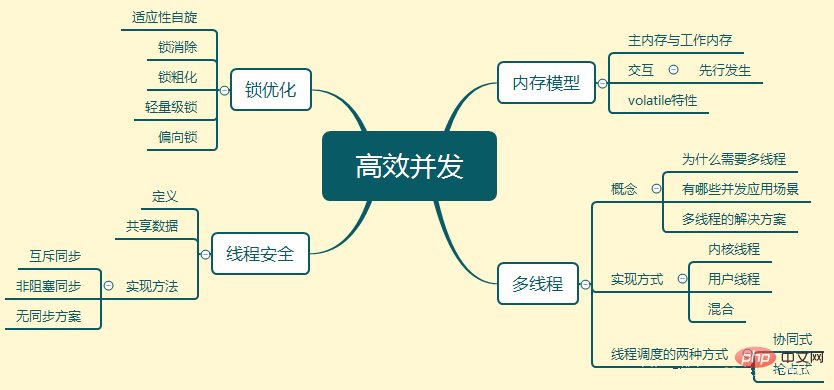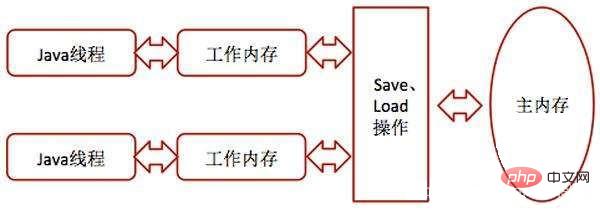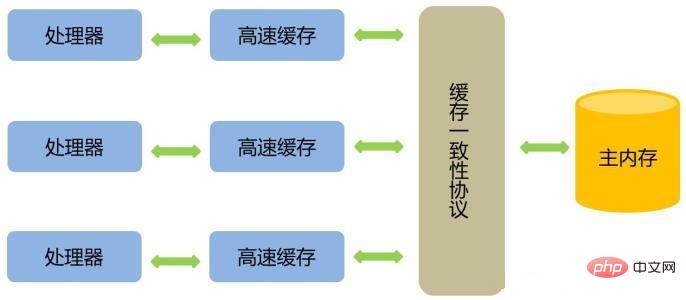 Java
Java
 javaTutorial
javaTutorial
 Detailed introduction to JAVA virtual machine (JVM) (8) - efficient concurrency
Detailed introduction to JAVA virtual machine (JVM) (8) - efficient concurrency
Detailed introduction to JAVA virtual machine (JVM) (8) - efficient concurrency

Memory model
The memory model is a specific operation protocol for a specific memory or The cache abstracts the process for read and write access. Its main goal is to define access rules for various variables in the program.
Main memory and working memory

All variables are stored in main memory. Each thread also has its own working memory. In its working memory is a copy of the main memory of the variables used by the thread. The thread's copy of the variable Operations such as reading and assignment must be performed in the working memory, and variables in the main memory cannot be read directly.
Inter-memory interaction operations
Copy from main memory to working memory: perform read and load operations sequentially.
Working memory is synchronized to main memory: store and write operations.
Characteristics of volatile
Volatile has the same function as synchronized, but is more lightweight than synchronized. Its main features are as follows:
Ensure the visibility of this variable to all threads
What does it mean? It means that when a thread modifies the value of this variable, the new value is immediately known to other threads. Ordinary variables cannot do this. The transfer of ordinary variable values between threads needs to be completed through main memory. For example, thread A modifies the value of an ordinary variable and then writes it back to the main memory. Another thread B is in thread B. After A completes the write-back and then reads from the main memory, the new variable value will be visible to thread B.
Disable instruction reordering optimization
Because instruction reordering will interfere with the concurrent execution of the program.
Multithreading
Why do you need multithreading?
The gap between the computing speed of the computer and the speed of its storage and communication subsystem is too large. A lot of time is spent on disk I/O, network communication, and database access. Using multi-threading can better utilize the CPU.
What are the concurrent application scenarios?
Make full use of your computer processor
A server provides services to multiple clients at the same time
How to make the processor internal Are the computing units fully utilized?
Add a layer of cache
Copy the data needed for the operation to the cache so that the operation can Do it quickly. When the operation is completed, it is synchronized back to the memory from the cache, so that the processor does not have to wait for slow memory reads and writes. However, there is a problem to consider: how to ensure cache consistency.

Optimize out-of-order execution of input code
Thread implementation
Using kernel threads to implement
Kernel threads are threads directly supported by the operating system kernel.
Use user threads to achieve
The establishment, synchronization, destruction and scheduling of user threads are completely completed in user mode without the help of the kernel, and the kernel does not An implementation that is unaware of the existence of threads. This implementation is rarely used.
Use user threads plus lightweight for hybrid implementation
Merge together
Thread scheduling
Thread scheduling refers to the process by which the system allocates processor usage rights to threads. There are two main types: collaborative and preemptive.
Cooperative
The execution time of the thread is controlled by the thread itself. After the thread finishes executing its work, it will actively notify the system to switch to another thread.
The advantage is that it is simple to implement and there is no thread synchronization problem. The disadvantage is that if there is a problem with the programming of a thread and the system is not told to switch threads, the program will always be blocked there, which can easily cause the system to crash.
Preemptive
Threads will be allocated execution time by the system, and thread switching is not determined by itself. This is the thread scheduling method used by java.
Thread safety
#When multiple threads access an object, if the scheduling of this thread in the runtime environment is not considered and alternate execution, there is no need for additional synchronization, or any other coordination operations on the caller. The behavior of calling this object can obtain the correct result, then this object is safe.
Classification of shared data
Immutable
Immutable shared data is data modified with final, which must be thread-safe. If the shared data is a basic type variable, just use the final keyword when defining it.
If the shared data is an object, then the behavior of the object needs to not affect its state. You can declare all variables with state in the object as final. For example, the String class is an immutable class
Absolutely thread-safe
Mark yourself as a thread-safe class in the Java API. Most of them are not absolutely thread-safe. For example, Vector is a thread-safe collection, and all its methods are modified to be synchronized, but in a multi-threaded environment, it is still not synchronized.
Relative thread safety
Relative thread safety is what we usually call thread safety. It can only guarantee that individual operations on this object are thread-safe. However, for some specific sequences of consecutive calls, it may be necessary to use additional synchronization means on the calling side to ensure the correctness of the calls.
Most thread-safe classes belong to this type.
Thread compatible
The object itself is not linearly safe, but it can be made through the correct use of synchronization means on the calling side To ensure that objects can be used safely in concurrent environments. Most classes that are not thread-safe fall into this category.
Thread opposition
No matter what, it cannot be used concurrently in a multi-threaded environment, such as System.setIn( ), System.SetOut(). One modifies the input and the other modifies the output. The two cannot be "alternately" performed.
Implementation method
##Method 1: Mutually exclusive synchronization - pessimistic concurrency strategy
Method 2: Non-blocking synchronization - Optimistic concurrency strategy
Perform the operation first, if there are no other threads competing for shared data , then the operation is successful; if there is contention for the shared data and a conflict occurs, other compensatory measures will be taken.
Method 3: No synchronization scheme
If a The method does not involve sharing data, so there is no need for synchronization measures. Such as repeatable code and thread-local storage.
(1) Reentrant code
If a method’s return result is predictable and can return the same result as long as the same data is input, then it Meets reentrancy requirements.
(2) Thread local storage
If the data required in a piece of code must be shared with other codes, and the codes that share data are executed in the same thread, in this way, we can The visible range of shared data is limited to one thread, so that no synchronization is needed to ensure that there are no data contention problems between threads.
Lock optimization
Adaptive spin
Because of blocking or waking up a JAVA thread The operating system needs to switch the CPU state to complete, and this state transition requires processor time. If the content in the synchronization code block is too simple, it is likely that the state transition will take longer than the execution time of the user code.
In order to solve this problem, we can let the subsequent thread requesting the lock "wait a moment", execute a busy loop, and spin. No processor execution time is given up at this time. If the spin exceeds the limited number of times and the lock is still not successfully obtained, the traditional method will be used to suspend the thread.
So what is adaptive spin?
On the same lock object, if the spin wait has just successfully obtained the lock, the virtual machine will think that the probability of obtaining the lock by spin is very high, and will allow it to spin. The wait lasts relatively longer. Conversely, if spin rarely succeeds in acquiring overlock, the spin process may be omitted.
Lock elimination
refers to the virtual machine just-in-time compiler running , Eliminate locks that require synchronization in some codes but are detected as unlikely to have shared data competition.
Lock coarsening
If a series of consecutive operations repeatedly lock and unlock the same object, or even the locking operation occurs in the loop body, then even if there is no thread competition, frequent mutual exclusion synchronization operations will Cause unnecessary performance loss.
If the virtual machine detects that a series of fragmented operations all lock the same object, it will coarsen the scope of lock synchronization to the outside of the entire operation sequence, so that it only needs to lock once.
Lightweight lock
Without multi-thread competition, reduce Traditional heavyweight locks incur performance penalties using operating system mutexes.
Applicable scenarios: No actual competition, multiple threads use locks alternately; short-term lock competition is allowed.
Biased lock
Biased lock is used to reduce the use of no competition and only one thread In the case of locks, the performance consumption caused by using lightweight locks. A lightweight lock requires at least one CAS each time it applies for and releases a lock, but a biased lock only requires one CAS during initialization.
Applicable scenarios: There is no actual competition, and only the first thread to apply for the lock will use the lock in the future.
The above is a detailed introduction to efficient concurrency in JAVA virtual machines. For more related questions, please visit the PHP Chinese website: JAVA Video Tutorial
The above is the detailed content of Detailed introduction to JAVA virtual machine (JVM) (8) - efficient concurrency. For more information, please follow other related articles on the PHP Chinese website!

Hot AI Tools

Undresser.AI Undress
AI-powered app for creating realistic nude photos

AI Clothes Remover
Online AI tool for removing clothes from photos.

Undress AI Tool
Undress images for free

Clothoff.io
AI clothes remover

Video Face Swap
Swap faces in any video effortlessly with our completely free AI face swap tool!

Hot Article

Hot Tools

Notepad++7.3.1
Easy-to-use and free code editor

SublimeText3 Chinese version
Chinese version, very easy to use

Zend Studio 13.0.1
Powerful PHP integrated development environment

Dreamweaver CS6
Visual web development tools

SublimeText3 Mac version
God-level code editing software (SublimeText3)

Hot Topics
 1654
1654
 14
14
 1413
1413
 52
52
 1306
1306
 25
25
 1252
1252
 29
29
 1225
1225
 24
24
 A distributed JVM monitoring tool, very practical!
Aug 15, 2023 pm 05:15 PM
A distributed JVM monitoring tool, very practical!
Aug 15, 2023 pm 05:15 PM
This project is designed to facilitate developers to monitor multiple remote host JVMs faster. If your project is Spring boot, it is very easy to integrate. Just introduce the jar package. If it is not Spring boot, don’t be discouraged. You can quickly initialize a Spring boot program and introduce it yourself. Jar package is enough
 JVM memory management key points and precautions
Feb 20, 2024 am 10:26 AM
JVM memory management key points and precautions
Feb 20, 2024 am 10:26 AM
Key points and precautions for mastering JVM memory usage JVM (JavaVirtualMachine) is the environment in which Java applications run, and the most important one is the memory management of the JVM. Properly managing JVM memory can not only improve application performance, but also avoid problems such as memory leaks and memory overflows. This article will introduce the key points and considerations of JVM memory usage and provide some specific code examples. JVM memory partitions JVM memory is mainly divided into the following areas: Heap (He
 Detailed explanation of JVM command line parameters: the secret weapon to control JVM operation
May 09, 2024 pm 01:33 PM
Detailed explanation of JVM command line parameters: the secret weapon to control JVM operation
May 09, 2024 pm 01:33 PM
JVM command line parameters allow you to adjust JVM behavior at a fine-grained level. The common parameters include: Set the Java heap size (-Xms, -Xmx) Set the new generation size (-Xmn) Enable the parallel garbage collector (-XX:+UseParallelGC) Reduce the memory usage of the Survivor area (-XX:-ReduceSurvivorSetInMemory) Eliminate redundancy Eliminate garbage collection (-XX:-EliminateRedundantGCs) Print garbage collection information (-XX:+PrintGC) Use the G1 garbage collector (-XX:-UseG1GC) Set the maximum garbage collection pause time (-XX:MaxGCPau
 Java Error: JVM memory overflow error, how to deal with and avoid
Jun 24, 2023 pm 02:19 PM
Java Error: JVM memory overflow error, how to deal with and avoid
Jun 24, 2023 pm 02:19 PM
Java is a popular programming language. During the development of Java applications, you may encounter JVM memory overflow errors. This error usually causes the application to crash, affecting the user experience. This article will explore the causes of JVM memory overflow errors and how to deal with and avoid such errors. What is JVM memory overflow error? The Java Virtual Machine (JVM) is the running environment for Java applications. In the JVM, memory is divided into multiple areas, including heap, method area, stack, etc. The heap is used to store created objects
 Analysis of the functions and principles of JVM virtual machine
Feb 22, 2024 pm 01:54 PM
Analysis of the functions and principles of JVM virtual machine
Feb 22, 2024 pm 01:54 PM
An introduction to the analysis of the functions and principles of the JVM virtual machine: The JVM (JavaVirtualMachine) virtual machine is one of the core components of the Java programming language, and it is one of the biggest selling points of Java. The role of the JVM is to compile Java source code into bytecodes and be responsible for executing these bytecodes. This article will introduce the role of JVM and how it works, and provide some code examples to help readers understand better. Function: The main function of JVM is to solve the problem of portability of Java programs on different platforms.
 Demystifying the working principle of JVM: In-depth exploration of the principles of Java virtual machine
Feb 18, 2024 pm 12:28 PM
Demystifying the working principle of JVM: In-depth exploration of the principles of Java virtual machine
Feb 18, 2024 pm 12:28 PM
Detailed explanation of JVM principles: In-depth exploration of the working principle of the Java virtual machine requires specific code examples 1. Introduction With the rapid development and widespread application of the Java programming language, the Java Virtual Machine (JavaVirtualMachine, referred to as JVM) has also become indispensable in software development. a part of. As the running environment for Java programs, JVM can provide cross-platform features, allowing Java programs to run on different operating systems. In this article, we will delve into how the JVM works
 How to adjust JVM heap memory size efficiently?
Feb 18, 2024 pm 01:39 PM
How to adjust JVM heap memory size efficiently?
Feb 18, 2024 pm 01:39 PM
JVM memory parameter settings: How to reasonably adjust the heap memory size? In Java applications, the JVM is the key component responsible for managing memory. Among them, heap memory is used to store object instances. The size setting of heap memory has an important impact on the performance and stability of the application. This article will introduce how to reasonably adjust the heap memory size, with specific code examples. First, we need to understand some basic knowledge about JVM memory. The JVM's memory is divided into several areas, including heap memory, stack memory, method area, etc. in
 Java program to check if JVM is 32-bit or 64-bit
Sep 05, 2023 pm 06:37 PM
Java program to check if JVM is 32-bit or 64-bit
Sep 05, 2023 pm 06:37 PM
Before writing a java program to check whether the JVM is 32-bit or 64-bit, let us first discuss about the JVM. JVM is a java virtual machine, responsible for executing bytecode. It is part of the Java Runtime Environment (JRE). We all know that java is platform independent, but JVM is platform dependent. We need separate JVM for each operating system. If we have the bytecode of any java source code, we can easily run it on any platform due to JVM. The entire process of java file execution is as follows - First, we save the java source code with .java extension and the compiler converts it into bytecode with .class extension. This happens at compile time. Now, at runtime, J



